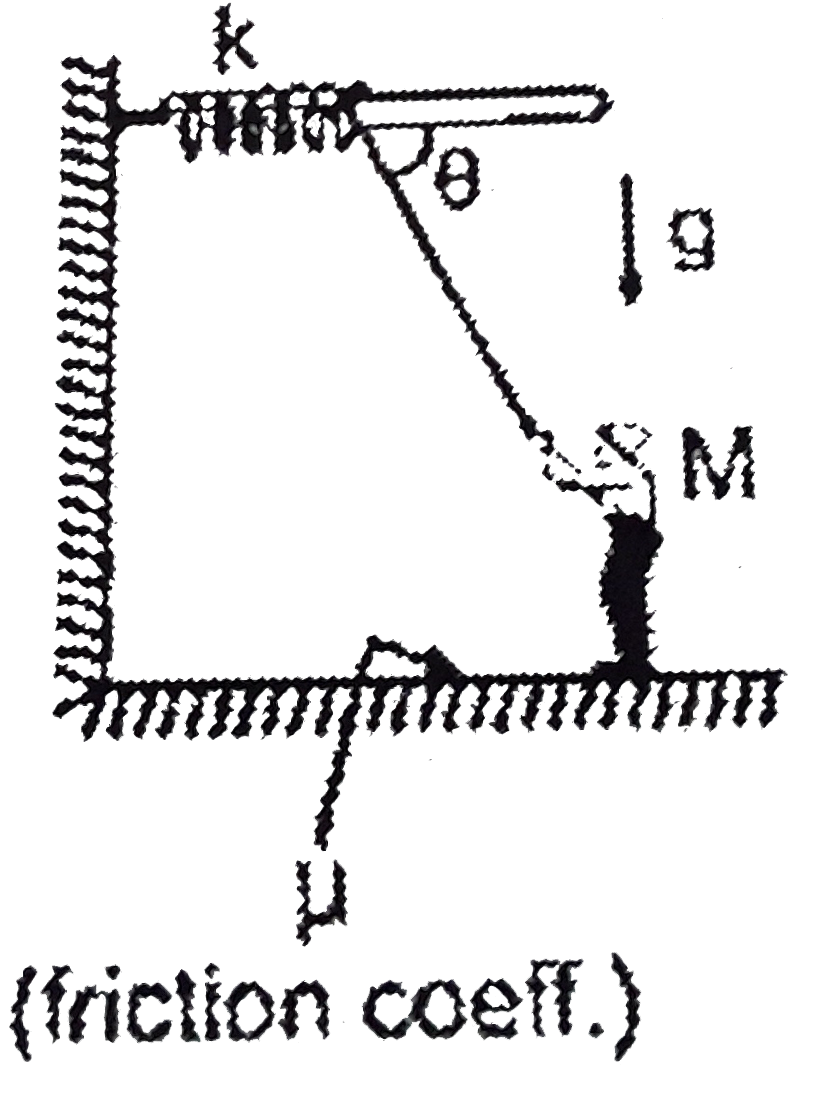A string of length 40 cm and weighing 10 g is attached to a spring at one end and to a fixed wall at the other end. The spring has a spring constant of 160Nm−1 and is stretched by 1.0 cm. If a wave pulse is produced on the string near the wall, how much time will it take to reach the spring ? Solution in Tamil
L=40 cm, mass=10gm
………mass per unit length
=1040=14(gmcm)
Spr∈gcostant=k=160Nm
Deflection =x=1cm<br>=0.01m<br>rarr T=kx=160x0.01<br>=1.6N=6xx10^4 dyne<br>Aga∈v=sqrt((T/m)0=sqrt(((16x10^4)/(1/4)))<br>=8xx10^2cm/s=800cm/s<br>:. time taken by the pulse to reach the spring. t=40800=120=0.05sec
Topper's Solved these Questions
Similar Questions
A mechanical wave propagastes in a medium along the X-axis. The particles of the medium moves in what direction?
03:02View SolutionThe gravitational force acting on a particle of 1 g due to a similar particle is equal to 6.67×10−17N. Calculate the separation between the particles.
04:45View SolutionThe mass of a cyclist together with the bicycle is 90 kg. Calculate the work done by cyclist if the speed increases from 6km/h to 12 km/h.
04:04View SolutionOne end of a light spring of spring constant k is fixed to a wall and the other end is tied to a block placed on a smooth horizontal surface. In a displacement, the work by the spring is 12kx2. The possible cases are
03:47View SolutionA block of mass 2.0 kg is moving on a frictionless horizontal surface with a velocity of 1.0 m/s figure towards abnother block of equal mass kept at rest. The spring constant of the spring fixed at one end is 100 The spring constant of the spring fixed at one end is 10 N/m. Find the maximum compression of the spring.
07:13View SolutionA block of mass m is attached to one end of a mass less spring of spring constant k. the other end of spring is fixed to a wall the block can move on a horizontal rough surface. The coefficient of friction between the block and the surface is mu then the compession of the spring for which maximum extension of the spring becomes half of maximum compression is .
02:14View SolutionOne end of a light spring of spring constant k is fixed to a wall and the other end is tied to a block placed on a smooth horizontal surface. In a displacment, the work done by the spring is +(12)kx2. The possible cases are.
03:27View SolutionA spring has natural length 40cm and spring constant 500N/m. A block of mass 1kg is attached at one end of the spring and other end of the spring is attached to a ceiling. The block is relesed from the position, where the spring has length 45cm.
05:50View SolutionA spring of spring constant k stores 5 J of energy when stretched by 25 cm. It is kept vertical with one end fixed. A mass m is attached to the other end. It maskes 5 Oscillation per second. Then
02:28View SolutionA uniform light spring has unstretched length of 3.0 m. One of its end is fixed to a wall. A particle of mass m = 20 g is glued to the spring at a point 1.0 m away from its fixed end. The free end of the spring is pulled away from the wall at a constant speed of 5 cm/s. Assume that the spring remains horizontal (i.e., neglect gravity). Force constant of spring = 0.6 N / cm. (a) With what speed does the particle of mass m move? (b) Find the force applied by the external agent pulling the spring at time 2.0 s after he started pulling.
02:28View SolutionA man with mass M has its string'.attached to one end. of a spring which can move without friction along a horizontal, overhead fixed rod. The other end of the spring is fixed to a, wall. The spring constant is k. The string is massless and inextensible and it maintains a constant angle θ with the, overhead rod, even when the man moves. There is friction, iwith coefficient μ between the man and the ground. What is, the maximum distance (in m ) that the man moving slowly can stretch the spring beyond its natural length?
 View Solution
View SolutionA spring of force constant K rests on a smooth floor, with one end fixed to a wall. A block of mass m hits the free end of the spring with velocity v. The maximum force exerted by the spring on the wall is
03:39View SolutionA load attached to the end of a spring and in equilibrium produces 9 cm extension of spring. If the spring is cut into three equal parts and one end of reach is fixed at 'O' and other ends are attached to the same load, the tension in cm of the combination in equilibrium now is :
02:08View SolutionA block of mass 3kg is attached with an ideal spring of spring constant 900 N/m. The other end of the spring connected with a rigid wall. A fixed convex mirror of radius of curvature 120 cm is placed at a distance 110 cm from the block and the spring is in its natural length. the spring is extended by 100 cm and released. the speed of the image of block is (15n)ms, when extension in the spring remains 50 cm. Find the value of 'n'.
 03:58View Solution
03:58View Solutionद्रव्यमान 10 g तथा लंबाई 40cm कि डोरी का एक सिरा एक दीवार से बँधा है दूसरा सिरा एक स्प्रिंग से जोड़ा है । स्प्रिंग अपनी स्वाभाविक लंबाई से 1.0cm खिँचा हुआ है तथा इसका स्प्रिंग नियतांक 160N/m है । यदि इस डोरी पर दीवार के पास एक तरंगिका उत्पन्न कि जाए तो उसे स्प्रिंग तक पहुँचने में कितना समय लगेगा ।
01:29View SolutionA spring has spring constant k=200N/m. How much work does it take to stetch the spring
10 cm from equilibrium ?View Solution

